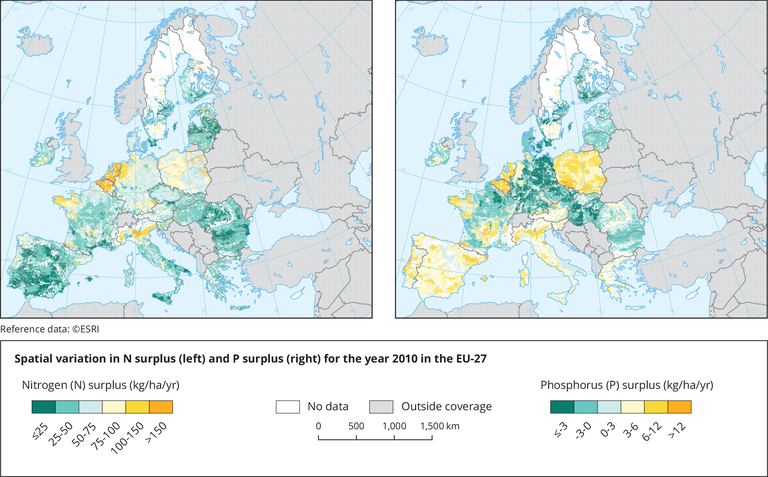All official European Union website addresses are in the europa.eu domain.
See all EU institutions and bodiesThe figure shows the spatial variation in nitrogen (N) surplus (left map) and phosporus (P) surplus (right map) for all agricultural land in the EU-27 in 2010 (excluding the United Kingdom and Croatia).
The surplus for N is calculated as the sum of N inputs to land (fertiliser, manure and biosolids, atmospheric N deposition, biological fixation and net mineralisation) minus crop removal (offtake). The surplus for P is calculdated as the sum of P inputs to land (fertiliser, manure and biosolids, atmospheric P deposition) minus crop removal (offtake).
In the two maps, regions with higher N and P surpluses are coloured in shades of orange and red (with red colours representing N surpluses over 150 kg/ha/yr and P surpluses of 12 kg/ha/yr, respectively). Regions with lower N and P surpluses are shown in shades of green. N surpluses occur in nearly all regions, and are highest in areas with high livestock densities such as the Netherlands, Belgium, Brittany in France and the Po valley region in Italy. Because P is adsorbed by the soil, P surpluses can be negative in areas where crop uptake exceeds P input and P inputs are completely eliminated (so-called P mining), such as in parts of France, Germany, Czechia, Slovakia and Hungary.
The maps and the supporting information are adapted from De Vries, W., Romkens, P., Kros, H., Voogd, J.C.H., Schulte-Uebbing, L., 2022, Impacts of nutrients and heavy metals in European agriculture. Current and critical inputs in relation to air, soil and water quality, ETC-DI Report 2022/01, European Environment Agency.

